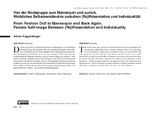Citation link:
http://dx.doi.org/10.25819/dedo/132Files in This Item:
| File | Description | Size | Format | |
|---|---|---|---|---|
| Guggenberger_Von_der_Modepuppe_zum_Mannequin_70-77_Dedo5.pdf | 2.38 MB | Adobe PDF |  View/Open |
| Dokument Type: | Article | metadata.dc.title: | Von der Modepuppe zum Mannequin und zurück. Weibliches Selbstverständnis zwischen (Re)Präsentation und Individualität | Other Titles: | From Fashion Doll to Mannequin and Back Again. Female Self-Image Between (Re)Presentation and Individuality | Authors: | Guggenberger, Aliena | Free keywords: | Pandora, Modepuppen, Mannequins, Reform-Bewegung, Pandora, fashion dolls, mannequins, reform movement | Issue Date: | 2022 | Publish Date: | 2022 | Publisher: | universi - Universitätsverlag Siegen | Journal: | denkste: puppe / just a bit of: doll (de:do) | Source: | denkste: puppe - multidisziplinäre zeitschrift für mensch-puppen-diskurse; Bd. 5 Nr. 1 (2022): Puppen und Puppenfiguren in Narrativen – Themen und Motive in Literatur, Kunst, Theater, Film, Medien, Alltags- und Populärkulturen ; 70-77 | Abstract: | Der Beitrag zeichnet die Entwicklungslinie der Modepuppe bis zum lebendigen Mannequin nach und beleuchtet dabei die symbolische Kehrseite einer weiblichen Uniformität, die bis heute Gültigkeit besitzt. Modepüppchen sind im heutigen Sprachgebrauch übertrieben auf ihr Aussehen bedachte, oft belächelte Personen. Ausgangspunkt des Püppchen-Narrativs sind sog. Pandora-Puppen, die seit dem 17. Jahrhundert weibliche Angehörige europäischer Königshäuser über die neuesten Modetrends unterrichteten. Ihre Mission entpuppte sich als Unheil bringend, übertrug sich doch ihre Funktion als steifes Präsentationsmodell auf die menschliche Trägerin der feinen Kleider. Der um 1900 von Reform-Bewegungen kritisierte puppenartige Frauentypus bildet – Metapher und Realität zugleich – den zentralen Anknüpfungspunkt. This article traces the evolution of the fashion doll to the living mannequin, illuminating the symbolic flip side of a female uniformity that is still valid today. In current parlance, fashion dolls are fashion victims; overly concerned with their appearance and often ridiculed. The origin of the doll narrative are so-called Pandora dolls, which instructed ladies of European royal houses about the latest fashion trends since the 17th century. Their mission turned out to be disastrous, as their function as a stiff presentation model was reassigned directly to the human wearer of the fine dresses. The doll-like type of woman criticized by reform movements around 1900 forms - metaphor and reality at the same time - the central reference |
DOI: | http://dx.doi.org/10.25819/dedo/132 | URN: | urn:nbn:de:hbz:467-24134 | URI: | https://dedo.ub.uni-siegen.de/index.php/de_do/article/view/132 https://dspace.ub.uni-siegen.de/handle/ubsi/2413 |
License: | http://creativecommons.org/licenses/by-sa/4.0/ |
| Appears in Collections: | universi - Zeitschriftenartikel |
This item is protected by original copyright |
Page view(s)
191
checked on Mar 10, 2025
Download(s)
171
checked on Mar 10, 2025
Google ScholarTM
Check
Altmetric
This item is licensed under a Creative Commons License


